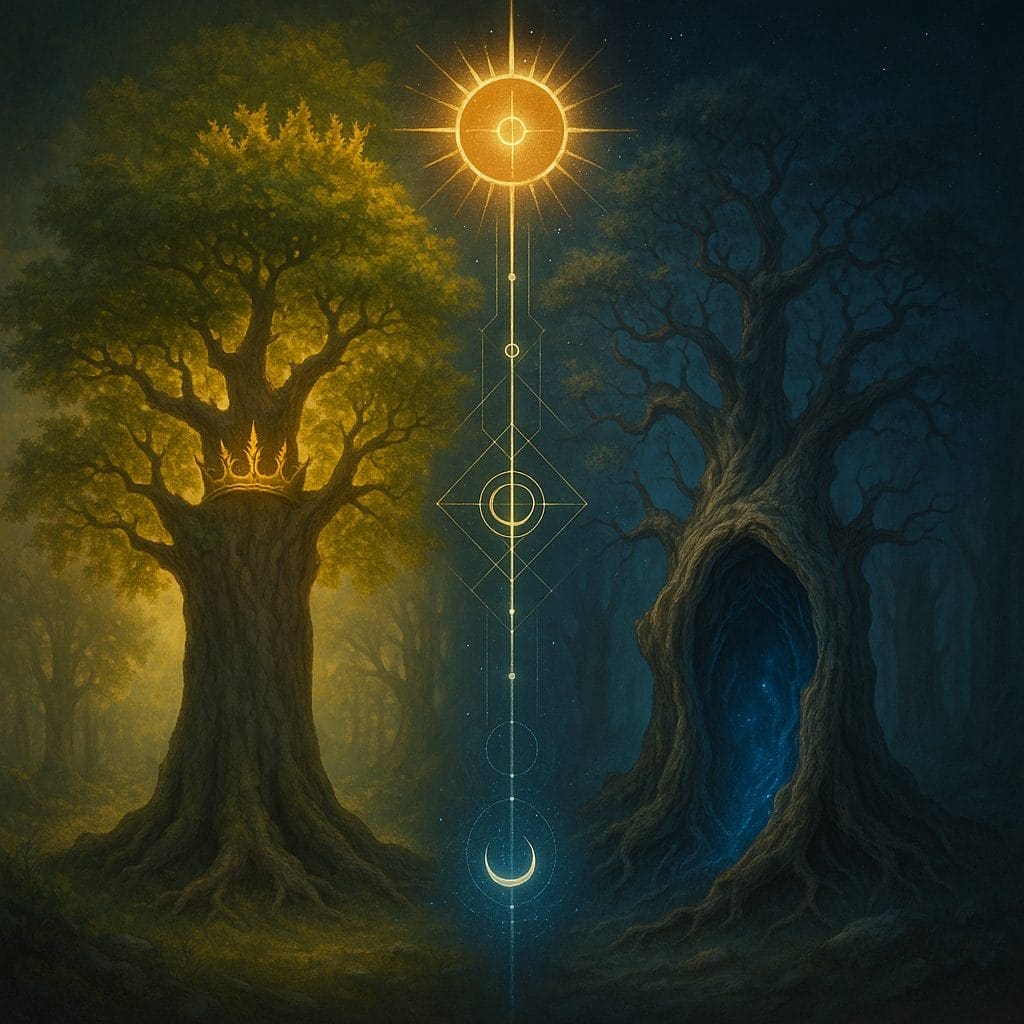The Divine Masculine and the Dark Masculine
The Divine Masculine and the Dark Masculine: The King Oak and the Hollow Oak Traditions

Together, they form a spiritual dialectic: the Divine Masculine expressed through the King Oak, and the Dark Masculine through the Hollow Oak—not in opposition, but in complementary polarity.
The King Oak: Sovereign Radiance and the Solar Masculine
The King Oak rises in majesty, a beacon of divine order and generative power. In Celtic and Druidic traditions, the King Oak was often the heart of the sacred grove—revered as the embodiment of solar deities and the masculine principle aligned with clarity, structure, and service.
This is the masculine in its ascended form—illuminated by the light of consciousness, rooted in integrity, and expressed through generative leadership. It is not dominance masked as strength, but presence forged in responsibility and grace.
The King Oak holds the archetype of the Divine Masculine:
-
Sovereignty: A man who has become king of his inner realm, no longer ruled by fear, resentment, or unexamined desire.
-
Stewardship: He understands power not as possession, but as responsibility. He leads through care, not coercion.
-
Illumination: Aligned with the Sun, the King Oak shines with discernment, vision, and the creative fire of will-in-service.
Yet the King’s power is incomplete without descent. Light alone blinds. Without mystery, he ossifies. Without death, he cannot be reborn. This is where the Hollow Oak becomes essential.
The Hollow Oak: Lunar Depth and the Dark Masculine
The Hollow Oak is not a withered remnant of vitality, but a powerful threshold into the sacred underworld. Where the King Oak reaches toward the sun, the Hollow Oak opens inward—its trunk cavernous, its roots stretching deep into the mythic soil of shadow, mystery, and memory.
Aligned with moon magik and the underworld realms, the Hollow Oak does not oppose the King—it completes him. It is not the “broken masculine,” but the initiatory womb of death, descent, and the unseen. It is here that the Dark Masculine arises—not evil, but primordial, ancient, and alchemical.
The Hollow Oak is an initiator. Its medicine is not warmth but truth.
It is the place of:
-
Ritual Descent: The call to go below the surface of identity, persona, and performance. The Hollow Oak invites practitioners to enter the mythic dark—to face grief, rage, erotic wildness, forgotten memory, ancestral echoes.
-
Lunar Wisdom: Unlike the bright discernment of the sun, the Hollow Oak is governed by intuition, dreams, and the womb of the unconscious. It teaches in symbols, silence, and sensation.
-
Integration Through Presence: It offers no crown, but a chalice—inviting the practitioner to drink from the roots and confront the unhealed, unspoken, and unseen aspects of self.
The Hollow Oak is not pathology. It is powerful medicine. It is the Dark Masculine in its sacred form—not acting out shadow, but guiding us toward its embrace, transformation, and integration. It is the archetypal psychopomp—midwife of masculine wholeness.
Together: A Mythic Polarity of Masculine Power
When understood together, the King Oak and Hollow Oak form a sacred polarity:
-
The King Oak is the solar masculine: radiant, structured, oriented toward service and sovereignty.
-
The Hollow Oak is the lunar/underworld masculine: mysterious, catalytic, oriented toward transformation and inner alchemy.
They are not rivals. They are ritual counterparts. The King sits atop the mountain; the Hollow beckons from the cave. One holds the sword; the other, the cauldron.
The modern masculine crisis stems, in part, from the exile of the Hollow. In a culture obsessed with productivity, linearity, and control, few spaces exist for descent, grief, mystery, or sacred unravelling. And without the Hollow, the King cannot mature. He becomes brittle, performative, disconnected from the depths that would make his sovereignty real.
The Path Forward: Reuniting the Two Trees
Divine Masculine wholeness is not found in choosing one archetype over the other, but in initiatory embodiment of both. Each man must undergo the rites of descent—into grief, unknowing, sacred rage, sexual wildness, and ancestral shadow—and re-emerge not polished, but true. The Hollow Oak strips away illusion. Only then can the crown of the King Oak rest rightly upon the head.
This is not a path for the faint of heart.
It is a sacred ordeal: a spiral journey of death and renewal, guided by sun and moon, grove and cave, eagle and serpent. It requires circles of brothers, ritual containers, elder mirrors, and the courage to go where many refuse to tread.
But when these two oaks are integrated within the soul of a man, something ancient returns. He becomes a living myth—neither hollow nor performative, but whole. He leads not from conquest, but from communion. He does not flee his darkness, nor deny his light. He becomes a vessel for the sacred masculine in all its radiant, rooted glory.
Final Reflection: The Grove Within Rise of the Divine Masculine
You may ask: Where do I begin?
Begin where you are. But listen for the groves. The old stories. The dreams that haunt. The grief that waits. The path to the King Oak begins in light—but it will take you through the Hollow. And the way through the Hollow leads to your crown.
The forest remembers.
And so does your soul.
Enter the realm of deep men’s work through the Men’s Work Intensive. Next session of the MWI Program starts 1/2/26

